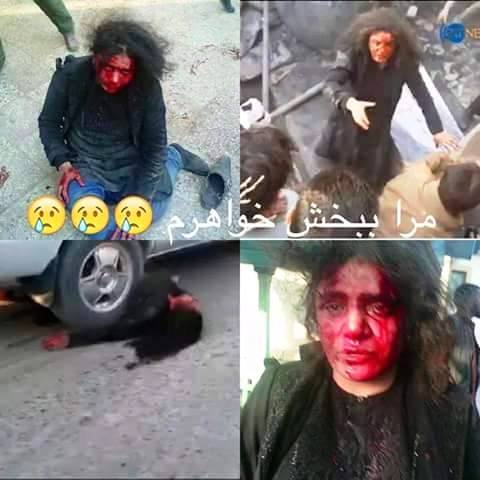KABUL” was more than enough to make people running toward the door of Shah-Do Shamshera shrine in the heart of Kabul on Thursday afternoon (March 19).
In the blink of an eye, dozens of men, mostly young boys, thronged the shrine where a woman — wearing a long black abaya and jeans — was already being tossed around by angry men in their early twenties. They were beating her in the head with sticks, calling her with obscene and vulgar words while shouting “Allah-o-Akbar.”
Shocking videos that immediately went viral on social media show the vulnerable woman, despite being kicked and punched, wanted to stand on her feet, but was thrown back repeatedly down to the ground. With messy hair and bleeding face, she screamed for help, trying to say something in her defence, but nobody gave her a chance.
The blows, kicks and strikes did not satisfy the angry mob and soon some started hitting her with stones and bricks. Others jumped on her legs and kicked her in the stomach. All these went on, according to some witnesses, for hours.
But she could still stand up as some took her to the roof of the shrine and pushed her back to the ground. This happened in full view of many police officers.
All her efforts and pleas to find help and a way out did not succeed. She then was dragged into the street and was driven over on the chest by a red Toyota Corolla.
The mob then dragged her half-naked bleeding body up to 200 metres and threw her into the Kabul River where the water has dried up.
In the highly graphic videos that is extremely difficult to watch, a man from the crowd brings a huge stone with difficulty and hit her with it. He repeats this for several times until it was clear her life was over and then he climbs up the walls of the banks of the river. Voices could be heard in the videos saying. “Haroon – Haroon hit her. Hit her it is Sawab,” a term for reward from God in return for doing something good.
Amid the loud noise, another voice could be heard saying: “Burn this infidel.” Immediately someone brings petrol and set her body alight. Some men throw their shawls on her to keep the fire alive until it reduces her body into ashes.
Three days later, she was buried in Khairkhana area and her coffin was carried by women.
Her savage murder sparked many protests in various parts of the country and drew condemnations.
Protesters who condemned her brutal killing planted a pine tree on the spot where she was burnt.
The ministries of interior and hajj and a fact-finding committee said their investigations showed no Quran’s burning incident had taken place at all.
Pajhwok Afghan News’ reporter visited the area on Thursday, exactly a week after the lynching, to talk to people there.
Many people had come to see the spot where the brutal act was committed, but no one was ready to talk.
Even local vendors and shopkeepers did not speak out when asked what words were actually exchanged between Farkhanda and the cleric, the main character in instigating the mob violence.
Despite the incident, a lot of women could still be seen coming to the shrine for prayers.
A silver-haired woman, visiting the shrine, angrily asked: “Where are the burnt pieces of the Quran?”
She condemned Farkhunda’s killing in strongest possible terms and prayed for her killers to be damned by Allah.
Engineer Najibullah, Farkhunda’ brother, told Pajhwok Afghan News that on the day she went out of home normally like other days. Before leaving home, she went to her father’s room asking for some money.
“Around 12pm my father called her to know where she was. She said she was in the shrine but did not say which one. Around 2pm, my mother called her and she said she was in the shrine and we could have lunch,” he said.
Najib said when they called her again around 3pm her mobile was off and they were unaware about what had happened to her.
With tears in his eyes, Najib said an hour later somebody called to his father, saying Farkhunda was no more. “Everybody was astounded,” he said, adding that after three worst days of his life, they finally laid her ashes to rest.
Farkhunda had studied at Bebe Bebe Sitara high school and Ayesha Sediqa Darul Uloom. She was also studying at Ustad Rabbani Education University and wanted to learn Tajwid as well.
Najib said Farkhunda would pray five times regularly and could recite the holy Quran by heart. “My sister was in love with Quran. She was graciously kind.”
Engineer Nader Malek, Farkhunda’s father, urged the government to detain her daughter’s killers and slap them with capital punishment.
“Farkhunda confronted an amulet seller to stop his anti-Islamic practice and stop deceiving people. The mullah got angry and blamed my daughter instead for burning the holy Quran,” he added.
Meanwhile, officials claimed initial investigations by a fact-finding committee showed Farkhanda did not burn the Quran and 27 suspects detained in the case would be referred to the Attorney General Office (AGO).
Mualvi Mohiuddin Baloch, head of the committee investigating Farkhanda’s killing, told journalists she was innocent.
He said 27 suspects in connection with her murder have been detained and their cases would be referred to the AGO coming Saturday.
Headed by Maulvi Baloch, the committee was formed following a presidential decree to investigate Farkhanda’s lynching from religious and legal perspectives.
Mualvi Mohammad Omar Farooqi, Mohammad Hussein Mohaqiqzada, Fauzia Kofi, Shinkai Karokhel, Shahla Farid, Mehbooba Saraj, Najibullah Azizi, Shamsullah Ahmadzai, Khpalwak Safi and Mujib Rahman Khilwatgar are among the committee members.
Baloch said findings of the committee would be submitted to President Ashraf Ghani.
Fauzia Kofi, a lawmaker and member of the committee, said Farkhanda’s killing was not preplanned. “Based on our findings and evidence, the Quran was not burnt and the papers torched had a Persian script on them.”
hg/ma
Views: 113









GET IN TOUCH
NEWSLETTER
SUGGEST A STORY
PAJHWOK MOBILE APP